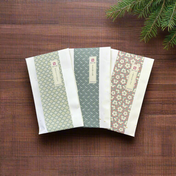Boil water, make tea, drink
Tea. Sen no Rikyu (1522-1591), the seminal master of Chanoyu (the “Japanese tea ceremony”), famously said, “All you must know about Chanoyu is simply this: Just boil the water, make the tea, and drink.” (The more commonly used translation is “The Way of Tea is naught but this: first you boil water, then you make the tea and drink it.”)
茶の湯とはただ湯をわかし茶を点ててのむばかりなることと知るべし
Chanoyu to ha tada yu wo wakasi cha wo tatete nomu bakari naru koto to shiru beshi
At first glance, it sounds like the master is saying tea making is simple. In fact that "Just" is loaded with nuance — to make tea well requires an effort to learn, practice, and refine; and the final result is that making tea becomes simple and second-nature.
But there's no need to feel stress or frustration. Like following a simple recipe, read the directions here, and simply try your best. With practice, tea making (or should we say "tea crafting"?) will become as natural as breathing.
Basic guidelines
While we have more specific recommendations for certain types of tea, the simplest guidelines for steeping Japanese green tea are this: Take 5 grams of tea, steep it in 200 ml hot water (70C/158F degrees) for about one minute. This is often what we put on Yunomi labels (though not always), and a basic guideline
Tea: 5 grams. Time: 60 seconds.
Water temperature: 70C/158F degrees. Water amount: 200 ml.
When making Japanese green tea, you generally don't make a large pot of tea, but a small pot, just enough for one cup (200 ml) or two sencha cups (100 ml) for two people. When you finish drinking your cup, you steep a second and third time (see below). Combining multiple steeps may average out the flavor, but is an easy way to make a larger amount (400-600 ml) of tea from one single serving of leaves.
Other steeping methods
- Ice Steeping
- Cold Water Steeping
- Steeping for Multiple People
Temperature is important!
Remember that water at hotter temperature extracts more, but the bitter flavors (i.e. caffeine and catechin) overwhelm sweet/umami flavors (L-theanine)
Water at cooler temperature extracts sweet/umami flavors without extracting the bitter flavors (which is why cooler temperatures are often used for high grade sencha, kabusecha, and gyokuro teas).
Do you need a thermometer? It doesn't hurt to use one. But drinking daily, it's not always practical. Instead remember this rule of thumb, allowing water to heat up a ceramic container generally decreases its temperature by about 10C/18F degrees. So if you have boiling water, warming up your pot, then your cups cools it down to 80C degrees. You may also use a second pot (or cooling bowl)
Tea amount, water amount
In addition to adjusting the temperature, increasing the amount of tea or decreasing the amount of water results in a more concentrated tea.
Use soft water
For tea, we generally recommend soft water (water that is low in minerals). Using filtered water is recommended if you live in an area where the tap water is hard. If using bottled water look on the label for a hardness level of 100 or lower.
Time
While black tea often requires 3-5 minutes steeping time, most Japanese green teas are made to be steeped in 1 minute or less. The finer (more powdery) the leaf itself is, the more likely that it will steep quickly—as little as 30 seconds may be needed. A hotter temperature will also extract flavor more quickly, so you may need to adjust the steeping time. If you are looking for a lighter flavor, use less tea or steep for a much quicker amount of time.
Steeping at cooler temperatures will extract flavor from the tea leaf more slowly, and so a longer steeping time is recommended in such cases.
GYOKURO, KABUSECHA, AND PREMIUM GREEN TEAS![]()
Shaded teas, like gyokuro and kabusecha, and other premium green teas are often characterized by rich umami notes, sweetness, and vibrant flavors. Steeping at lower temperatures allows these flavors infuse into the water slowly without the more bitter flavors that are extracted at higher temperatures. These teas are sometimes deep steamed (see below) and may steep faster as a result, so time adjustment may be necessary.
-
First Steeping
- Gyokuro (for the first few drops of deep umami syrup - generally reserved for the highest grades): 5 grams of tea leaf, 50 ml of water, 40-60C / 100-140F degrees, 2-3 minutes.
- Lower grades of gyokuro, kabusecha, and other high grade sencha, etc: 5 grams of tea leaf, 200 ml of water, 60-70C / 140-158F degrees, 1 minutes. (There is less umami flavor to be extracted so we don't recommend the syurp above, but it doesn't hurt to try either.)
-
Second steeping: the tea leaves should now be primed and an immediate pouring in and pour out of water is sufficient to extract flavor. This generally means the steeping lasts about 10 seconds. Use 200 ml of water at 70-80C / 158-176F degrees.
- Third steeping: 200 ml of water at 70-80C / 158-176F degrees, 30-60 seconds.
- Other recommended methods:
FUKAMUSHICHA
When Fukamushicha (literally "deep steamed tea") is processed, the long steaming time softens the leaf and it breaks apart into much smaller pieces when it is rolled. This means the leaf steeps much faster than whole, more intact leaves.
-
First Steeping
- 3-4 grams of tea leaf, 200 ml of water, 70C / 158F degrees, 30-45 seconds. (You can also follow the above syrup method if you are steeping deep-steamed gyokuro.)
-
Second steeping: the tea leaves should now be primed and an immediate pouring in and pour out of water is sufficient to extract flavor. This generally means the steeping lasts about 10 seconds. Use 200 ml of water at 70-80C / 158-176F degrees.
- Third steeping: 200 ml of water at 70-80C / 158-176F degrees, 30-60 seconds.
- Other recommended methods:
Hojicha, Genmaicha, and Bancha
Hojicha (roasted green tea), bancha (unroasted large-leaf green tea), and genmaicha (green tea mixed with toasted rice) are often made from larger tea leaves which tend to extract more slowly. So, using a slightly higher temperature is often appropriate. However, as these three tea types have a wide variety of teas included in them it is recommended to also test with different temperatures, amounts, and brewing times to find your perfect brewing method.
Note some dark tea (post-fermented) in Japan often carry the term "bancha" in its name, and have more specific steeping methods involving 5-10 minutes of steeping or boiling.
- First Steeping: 5 grams of tea leaf, 200 ml of water, 80-90C / 176-194F degrees, 30-60 seconds.
-
Second steeping: the tea leaves should now be primed and an immediate pouring in and pour out of water is sufficient to extract flavor. This generally means the steeping lasts about 10 seconds. Use 200 ml of water at 90C / 194F degrees.
- Third steeping: 200 ml of water at 80-90C / 176-194F degrees, 30-60 seconds.
- Other recommended methods:
Black Tea and Oolong
Teas like black tea and oolong tea usually produce the best results when brewed for multiple minutes in higher temperatures, as this allows the flavor profile to be extracted more fully. You can experiment with different temperatures and brewing times to see which combination produces your favorite steeping.
- First Steeping: 5 grams of tea leaf, 200 ml of water, 90C / 194F degrees, 3-5 minutes.
-
Second steeping: the tea leaves should now be primed. Use 200 ml of water at 90C / 194F degrees, and 1-2 minutes of steeping time.
- Third steeping: 200 ml of water at 70-80C / 158-176F degrees, 3-5 minutes.
- Other recommended methods:

